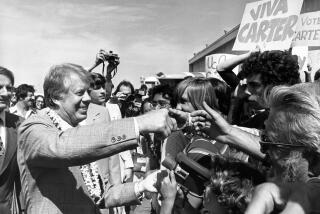What’s in a Name? Favoritism, Prejudice
- Share via
My high-school students used to elect Communists to office regularly, though unknowingly, as part of a unit that I taught on critical thinking.
They did so for two of the apparent reasons that led Illinois Democratic voters to choose two followers of Lyndon LaRouche as candidates for statewide office--ignorance and a tendency to favor good old American names. In Illinois, Mark J. Fairchild defeated George Sangmeister for the lieutenant governor nomination and Janice Hart edged out Aurelia Pucinski for the secretary of state nomination.
As an introduction to the critical-thinking unit, I handed students a “ballot” listing Offices 1 to 6 (no jobs specified), with four candidates for each: one “all-American” name along with three that were unusual, old-fashioned and/or foreign-sounding. The students were to mark one name for each office.
The catch was that the most “American” names were those of 1950s Communists--William Foster and Gus Hall, the party’s presidential candidates; Elizabeth Flynn and Eugene Dennis, long-time leaders; Robert Thompson, a party attorney, and Paul Robeson, the black singer who defected to Moscow.
The less apple-pie names on the list were those of Democratic and Republican officeholders or candidates, among them Herman Badillo, Ella Grasso, Spark Matsunaga, Guy Vander Jagt, Joseph Addabbo, Hiram Fong, Patsy Mink, Bella Abzug, Roman Hruska, Elford Cederberg, Eligio de la Garza, Jake Pickle, Silvio Conte and, ironically, Roman Pucinski, father of the defeated Aurelia.
As we began the unit, most students dutifully marked the ballot when I told them to, although a few demanded, “What are we doing this for?” To which I curtly replied, “Never mind! Do it anyway!” That cowed most, but there were occasional holdouts, as there should have been.
They were almost always startled to find that all or at least a majority of their winners were Communists.
After the votes were tallied, I asked for a show of hands on who voted for whom, and often a pattern became apparent. Except when they ganged up to vote for what they regarded as really far-out names, students of all backgrounds tended to pick common Anglo-Saxon names. Class discussion showed interesting subtrends, some of which revealed deep prejudices. Like their elders, some students voted for--or against--all women. Some marked the first name on each list. Some matched their own ethnic background. Some tabbed names that were “cute.”
That’s the way it went for the 25 years or so that I used this device, although some greater tolerance for ethnic candidates seemed to develop as the years from John F. Kennedy to Ronald Reagan went by.
I got the idea for my ballot from a 1944 election in my home state, Nebraska. The Democrats awakened the day after the primary to find that their candidate for governor was a 62-year-old busboy, usually clad in a tattered sweater. His platform was that he could square the circle, and he would run the state like that. Embarrassed party officials, who had ignored or smirked at the upstart, unsuccessfully sought to persuade him to step down.
His big draw was his name: George W. Olsen. Heavily Scandinavian Nebraska often elected candidates with names like Anderson, Swanson or Peterson. The Democratic organization candidate (against a popular Republican governor) that year had been Patrick Heaton--not a weird name, but not Scandinavian.
Olsen lost 3 to 1 in the general election. Apparently some voters still didn’t know who he was, or they were the sort who would have voted a straight ticket even if Hitler had been the candidate.
My unit was designed to make students think about how they made choices, and the moral to the story, at least as I told it, was this: “The key to your liberties is being aware. Know who you’re voting for, and if you don’t care enough to find out, don’t vote.”
That was sound advice when I gave it, and I still think so. I’ll bet that many in Illinois are thinking the same thing.
More to Read
Sign up for Essential California
The most important California stories and recommendations in your inbox every morning.
You may occasionally receive promotional content from the Los Angeles Times.













